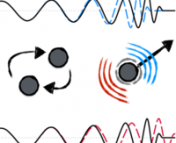Title: GW190521: a binary black hole merger inside an active galactic nucleus?
Authors: Sophia L. Morton, Stefano Rinaldi, Alejandro Torres-Orjuela, Andrea Derdzinski, M. Paola Vaccaro, and Walter Del Pozzo
First Author’s Institution: Department of Physics, Oregon State University, Corvallis, OR 97331, USA
Status: Published in Phys. Rev. D [closed access]
Gravitational wave astronomy has already provided us with numerous insights into the strange world of compact object physics; from neutron star mergers to a gravitational wave background, there exists a rich landscape of astrophysical phenomena which can be probed using gravitational waves. However, the ultimate goal of many researchers within the burgeoning field of multimessenger astronomy is not just to “listen” in as massive objects stir up the cosmic sea, but to correlate gravitational wave measurements with other types of astrophysical signals, like those from traditional electromagnetic astronomy or particle physics. So far the only strongly-confirmed example of such a multi-signal event is GW170817, a neutron star collision not only “heard” by LIGO but thought to be “seen” by the Fermi Gamma-ray Space Telescope only about 1 second later. In today’s paper, the authors provide evidence that a different kind of event was recently detected in both gravitational and electromagnetic waves 34 days apart. According to the paper, the two events may have originated from two black holes colliding while inside of the extreme environment surrounding a much larger supermassive black hole known as an active galactic nucleus, triggering a bright electromagnetic flare. What are the odds!? Let’s find out!
Falling Into the Mass Gap
Today’s paper centers on the gravitational wave event GW190521, which has been a source of significant intrigue for gravitational wave astronomers since its initial detection in 2019. While the name itself is characteristically unremarkable, the event currently stands as both the most massive black hole binary merger detected by the LIGO-Virgo-KAGRA collaboration to date and the first detection of a merger system containing an intermediate-mass black hole. The latter fact is the most tantalizing for researchers who are interested in understanding the formation and growth of astrophysical black holes—but what’s so shocking about finding a black hole with just plain-old intermediate mass? As it turns out, these black holes, which span anywhere from around 100 to 100,000 solar masses, don’t have any obvious formation mechanisms. One reason for this is that stars are not expected to easily collapse down to black holes heavier than ~50-80 solar masses (depending on that paper you look at!) due at least in part to a concept known as pair instability. On top of this, most stars don’t exist within environments that are dense enough to allow for the sort of extensive growth due to accretion necessary to boost these stellar black holes into the aforementioned “intermediate” mass range with enough regularity for these black holes to be commonly observed.
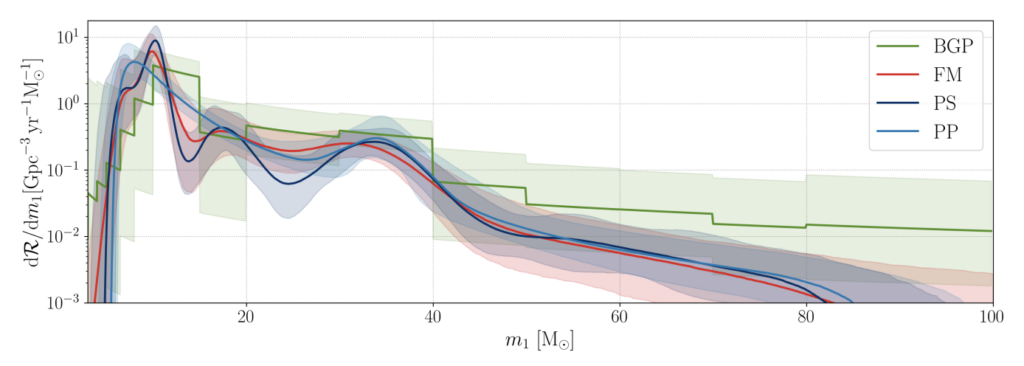
A Black Hole Around a Black Hole Around a Black Hole…
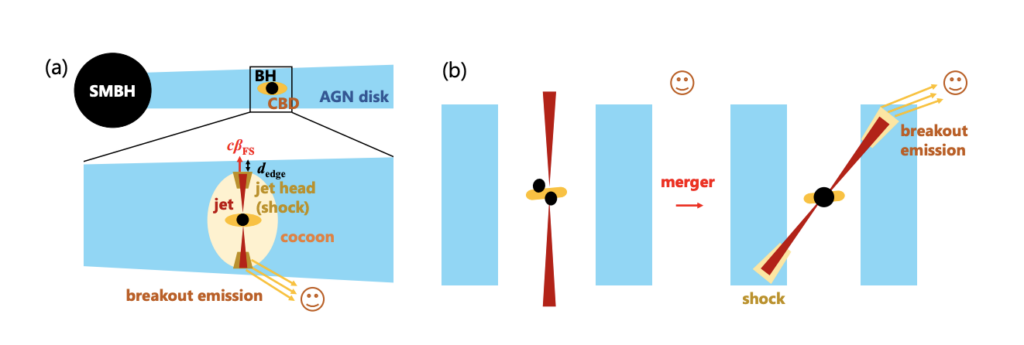
The lack of theoretical motivation for black holes in this mass range is called the “upper mass gap”, and beyond being theoretically motivated, there exists some (still inconclusive) evidence from binary merger population studies that a decrease in the rate of mergers occurs for systems with primary masses approaching 80 solar masses (as can be seen in figure 1). Therefore GW190521, first estimated to result from the merger of a 85 solar mass black hole with a 66 solar mass counterpart, stood out to researchers from the moment of its detection in 2019, with numerous proposals put forth for its possible origin in the following years. One explanation is that the binary system sat within a region of space containing abnormally high densities of surrounding gas and dust which could supply the black holes with a continuous stream of matter to accelerate their growth. A specific astrophysical environment that fits this description is that of an active galactic nucleus (AGN)—the region of hot gas surrounding supermassive black holes at the centers of some galaxies. As gasses sink down towards a central supermassive black hole, they can accelerate and heat up, ultimately forming extended disks which emit huge amounts of light due to their high temperatures. These dense and chaotic environments have been theorized as ideal places for both mergers between black holes and accretion of material onto black holes, allowing for rapid increases in their masses beyond what would be expected in other interstellar environments.
Adding to the intrigue of GW190521, a mere 34 days later another somewhat rare astrophysical event was observed by the Zwicky Transient Facility (ZTF) in the vicinity of the galaxy AGN J124942.3+344929, which sits within the part of the sky GW190521 was predicted to originate from. The event was a sudden brightening known as a flare and was given the designation ZTF19abanrhr (astronomers have great naming conventions!). Flares like this are a prediction of many of the aforementioned models of black hole mergers within AGN disks as the result of numerous processes during mergers which can rapidly heat the surrounding gas (see figure 2 for an example). AGN J124942.3+344929 was known to be quite stable in its emission of light in the months prior to the detection of ZTF19abanrhr making it seem even more plausible that the two rare events were correlated.
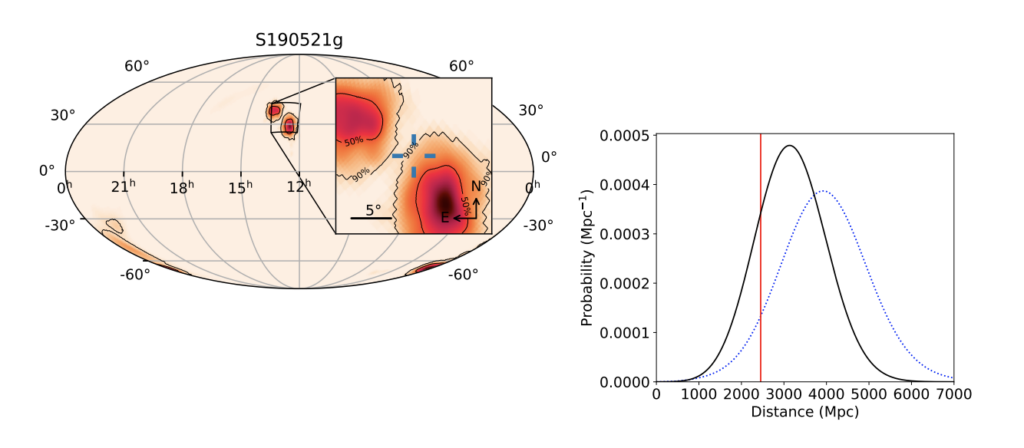
What are the Odds?
Whenever a statement like “these two rare events may be correlated” is made in a research paper, it’s a safe bet that the following analysis will involve a lot of statistics—and that is indeed the case for today’s paper, led by Sophia Morton from Oregon State University. In order to perform their analysis the authors employed Bayesian statistics, which is a convenient framework for comparing how well two models describe a single set of data, all the while taking into consideration the complexity of each model and prior information about the parameters involved. This sort of analysis, while mathematically rigorous, can produce slightly different results depending on what prior information is used. For example, in the case of GW190521, previous authors had explored its possible coincidence with ZTF19abanrhr but typically found little to no evidence for the events being associated. This was in part due to the original estimates for the gravitational wave’s properties strongly preferring that the signal originated from far behind the galaxy in which the flare was observed. However, in a recent update to the Gravitational Wave Transient Catalog (GWTC) made by the LIGO-Virgo-KAGRA collaboration, improved gravitational waveform modeling and noise reduction efforts shifted the estimated distance to GW190521, making the odds of spatial overlap with the flare significantly more likely.
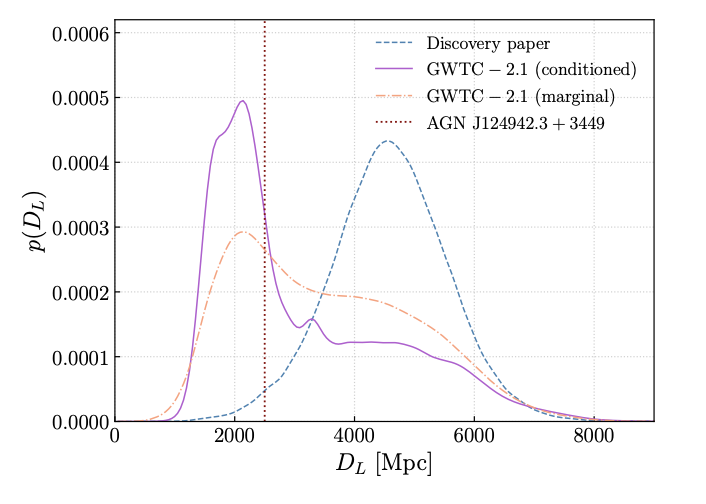
Given this renewed possibility of a spatial overlap, the authors prepared a new model comparison. Their model involved not only setting a prior distribution on the position of the gravitational wave signal, but also included parameters involving the redshifting or blueshifting of the waveform due to its motion around a central AGN, cosmological expansion between us and the signal, and its position within a deep gravitational well. By trying to find an ideal combination of these parameters the authors hope to be able to recover not just the masses of the merging black holes but also more AGN-specific details like the merging system’s distance from the central supermassive black hole. When comparing this model to that of a random coincidence between the two signals, a further penalty was applied to the “associative” model (in which the two signals were taken to be from the same event) based on the number of similar flares observed by the ZTF in the relevant span of time.
With all this prior information in hand, the authors found using Bayesian model selection techniques that the associative model was preferred over a random coincidence model with an odds ratio of 400:1. Roughly speaking this means that given the assumptions used within this analysis, the associative model was 400 times more likely to explain the data than a random chance coincidence. As an added bonus, the authors use this potential multimessenger detection to conduct a standard siren estimation of the cosmological parameter known as the Hubble constant (H0). We’ve written about standard sirens before several times at Astrobites; in short combining gravitational wave measurements with electromagnetic ones allows for a new kind of constraint on H0 which tells us how quickly the universe is expanding. The authors report a value around 100km/s/Mpc from the combination of the GW190521 and ZTF19abanrhr signals, but with large uncertainties which make it still somewhat consistent with estimates from surveys like SH0ES, which indicate an H0 of ~73km/s/Mpc. When analyzed jointly with the only well-confirmed prior multimessenger observation GW170817, however, they obtained an estimate of around 79km/s/Mpc with smaller error bars, putting this measurement in even closer alignment with independent ones. The authors note that the general agreement between their model’s recovery of H0 and existing estimates provides an additional piece of circumstantial evidence for the association between GW190521 and ZTF19abanrhr.
Betting Responsibly
As with all results of this kind, the very high odds ratio provided in this analysis is still dependent on a number of assumptions about the underlying models used. However, the result is still notable for its use of newer estimates for GW190521’s properties and its significantly positive result associating the two events. If evidence continues to build for such an association, it would be another truly novel detection in the already exciting new world of multimessenger astronomy—allowing for progress on the study of intermediate-mass black holes, AGN, the Hubble constant, and much more!
Featured image credit: Adapted by the author from NASA/JPL-Caltech and Figure 1 in Graham et al. 2020.
Astrobite edited by Emma Clarke

